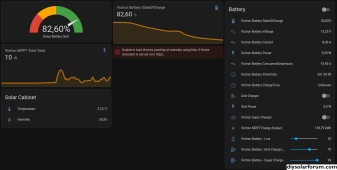Archerite
New Member
I have a small server, intel NUC, that uses less than 5 watts at 12-19 volt input. So it fit perfectly in the range of charging voltages for a lifepo4 battery. I have a 12V 8Ah lifepo4 cell I want to use for this UPS. Combined with a victron smartshunt/bmv to monitor the SoC. It will not be connected directly to solar, but I do have a larger battery bank this will be charged from. For all intents and purposes...this one is "unlimited" in it's capacity. Charged from either solar or grid automatically to keep it in the range 20%-50%.
On that "automated battery bank" I have two victron orion 12/24-10 that are in parallel for a 24.5V 20A line. This is where this UPS needs to be charged from. The 8Ah battery can take 10A of charge current but anything between 2-5A will be fine I think. Another victron orion is an option...but one that is actually meant for charging requires the smart version. Meaning at least 200+ euro's! I have a few MPPT's as reserves on the shelf...and I know it works by taking the 24V line into the MPPT's PV input.
My question is if there is a better solution to charge this battery. With the configurable charge profile like the MPPT has.
On that "automated battery bank" I have two victron orion 12/24-10 that are in parallel for a 24.5V 20A line. This is where this UPS needs to be charged from. The 8Ah battery can take 10A of charge current but anything between 2-5A will be fine I think. Another victron orion is an option...but one that is actually meant for charging requires the smart version. Meaning at least 200+ euro's! I have a few MPPT's as reserves on the shelf...and I know it works by taking the 24V line into the MPPT's PV input.
My question is if there is a better solution to charge this battery. With the configurable charge profile like the MPPT has.



